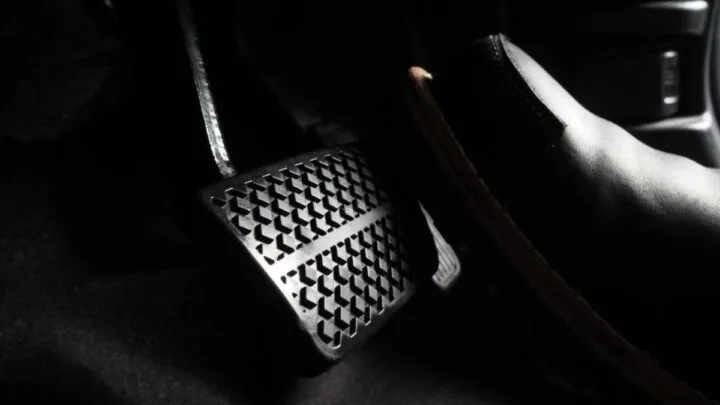One of the fastest-growing and innovative sectors in the automobile industry is the development of electric vehicles (EVs).
And every once in a while, you may hear the terms one-pedal driving and regenerative braking. What are they?
Well, Tesla is fast-moving to improve the efficiency of their vehicles through better, well-designed, and tested one-pedal driving systems.
But will they get rid of the brake pedal?
Tesla electric vehicles have brake pedals for those that prefer decelerating using the brakes. Conversely, you can drive without using the brake pedal in what’s referred to as one-pedal driving mode. However, one-pedal driving isn’t a standard feature in older Tesla models.
In today’s article, we’re looking at one-pedal driving and regenerative braking, their relation, and whether the system is beneficial to you. Let’s get going.

What’s One-Pedal Driving?
One pedal driving is a driving mode in electric vehicles whereby drivers can exclusively use the gas pedal while driving without needing a brake pedal. And how this system works is pretty simple.
When you usually press the gas pedal, your car will move forward or reverse. The more you press the pedal, the faster your car accelerates.
However, you’ll only need to get your foot off the gas pedal instead of pressing the brake pedal to decelerate.
Your Tesla’s electric motors will decelerate using a force of 0.2G (approximately 20% of your usual full braking force).
However, one-pedal driving may not work satisfactorily on low-traction surfaces, such as when driving on ice or snow.
Additionally, Tesla discourages motorists from using the feature when the EV’s batteries are fully charged.
A reason for this is that one-pedal driving decelerates by turning the motors in reverse and storing the energy generated in the batteries (more on this in the section below).
Now, what if the batteries are full? The simple answer is that the system is unpredictable and may not decelerate your Tesla in time.
How Tesla Is Addressing the Shortcomings of One-Pedal Driving
On the brighter side, Tesla recently released an update that addresses the shortcomings of one-pedal driving.
The update has an option that makes your car decelerate while driving on one pedal with or without regenerative braking.
When regenerative braking is limited, such as driving on a full battery, the car will automatically apply its regular brakes while decelerating.
However, as I’ve said, the feature is available through an update; hence you need to check with Tesla whether your car can support the feature or not.
But as of today, the feature is still being tried on specific Tesla Model Ys and Model 3s with supported hardware.
Moreover, some Tesla vehicle owners don’t appreciate their EVs decelerating independently without driver input. As a result, Tesla provides it as an optional feature that usually’s OFF.
To turn it on, go to Controls → Pedals and Steering → Apply Brakes When Regenerative Braking Is Limited.
But remember that it’s only for specific hardware and might not work in your Tesla.
What Is Regenerative Braking?
Electric vehicles apply a range of technologies and power-saving features to ensure maximum driving range with any available battery charge. And one of these features is regenerative braking. What is it?
To understand regenerative braking, we must first understand how conventional brake systems work.
Traditional brake systems commonly used in most vehicles worldwide use a combination of brake discs and pads on each wheel.
On activating the brakes, the pads and the discs come together, creating friction, and reducing the vehicle’s speed.
However, such a braking system isn’t efficient, especially for electric vehicles, as a lot of energy is dissipated in the form of heat while decelerating.
Therefore, most EV manufacturers prefer using regenerative braking alongside one-pedal driving.
Second, we need to understand how the battery pack and motor system work in a Tesla or any other electric vehicle. A motor is simply an electrical device that converts electrical to mechanical energy.
This mechanical energy then rotates a driving shaft and, in effect, your EV’s wheels.
Now, motors can behave as generators when the driving shaft is forcefully and mechanically rotated to create an electric field across its winding.
Now, let’s use that little piece of info to understand how electric vehicles work when accelerating and decelerating.
When decelerating through regenerative braking, the power supply to the motors is restricted, causing a reverse energy supply from the wheels (regeneration).
This forceful rotation of the motor’s shaft causes a buildup of electric current in the motors, which charges the batteries.
Advantages of One-Pedal Driving
Now that we’ve seen that Tesla supports one-pedal driving, a common concern on most people’s minds is how beneficial, or impactful the system is.
Here we’re looking at some of its benefits and whether they suit you.

Extends Brake Life
One-pedal driving is very beneficial for prolonging your vehicle’s brake life.
Typically, vehicle brakes wear out significantly faster if you decelerate harder while stepping on the brake pedal.
Hence, a system that reduces the amount of brake pressure needed for a stop will inadvertently reduce brake pad wear and tear and extend the time interval between changes.
Extends Maximum Driving Range
As we’ve seen, regenerative braking feeds power to the battery pack.
When you use it more often, you’re sure to improve your Tesla’s maximum driving range by some miles.
Convenience
If you find moving your foot between the brake and accelerator pedals to be cumbersome and unimpressive, then go for the one-pedal driving system.
However, if you’re doing so, take time to adjust to the system and learn how your Tesla responds to gauge your braking distances well.
Final Remarks on Teslas Having Brake Pedals
After years and years of driving with both the gas and brake pedals, it may take some time to “unlearn” your former driving habits.
Therefore, take time to adjust your driving technique before getting on the highways.
Additionally, one-pedal driving isn’t foolproof and may fail to respond adequately in emergencies.
In other words, you’re more likely to stop faster with an ABS-supported Tesla when pressing the brake pedal than when relying on regenerative braking.
